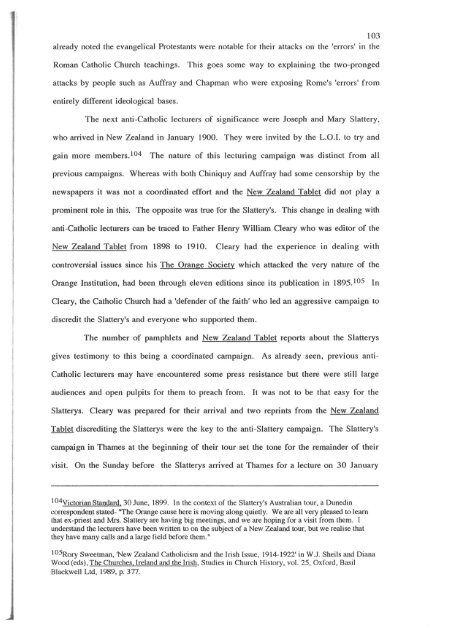TRANSPLANTED IRISH INSTITUTIONS - University of Canterbury
TRANSPLANTED IRISH INSTITUTIONS - University of Canterbury
TRANSPLANTED IRISH INSTITUTIONS - University of Canterbury
You also want an ePaper? Increase the reach of your titles
YUMPU automatically turns print PDFs into web optimized ePapers that Google loves.
103<br />
already noted the evangelical Protestants were notable for their attacks on the 'errors' in the<br />
Roman Catholic Church teachings. This goes some way to explaining the two-pronged<br />
attacks by people such as Auffray and Chapman who were exposing Rome's 'errors' from<br />
entirely different ideological bases.<br />
The next anti -Catholic lecturers <strong>of</strong> significance were Joseph and Mary Slattery,<br />
who arrived in New Zealand in January 1900. They were invited by the L.O.I. to try and<br />
gain more members. 104<br />
The nature <strong>of</strong> this lecturing campaign was distinct from all<br />
previous campaigns. Whereas with both Chiniquy and Auffray had some censorship by the<br />
newspapers it was not a coordinated effort and the New Zealand Tablet did not playa<br />
prominent role in this. The opposite was true for the Slattery's. This change in dealing with<br />
anti-Catholic lecturers can be traced to Father Henry William Cleary who was editor <strong>of</strong> the<br />
New Zealand Tablet from 1898 to 1910.<br />
Cleary had the experience in dealing with<br />
controversial issues since his The Orange Society which attacked the very nature <strong>of</strong> the<br />
Orange Institution, had been through eleven editions since its publication in 1895.105 In<br />
Geary, the Catholic Church had a 'defender <strong>of</strong> the faith' who led an aggressive campaign to<br />
discredit the Slattery's and everyone who supported them.<br />
The number <strong>of</strong> pamphlets and New Zealand Tablet reports about the Slatterys<br />
gives testimony to this being a coordinated campaign. As already seen, previous anti-<br />
Catholic lecturers may have encountered some press resistance but there were still large<br />
audiences and open pUlpits for them to preach from. It was not to be that easy for the<br />
Slatterys. Cleary was prepared for their arrival and two reprints from the New Zealand<br />
Tablet discrediting the Slatterys were the key to the anti-Slattery campaign. The Slattery's<br />
campaign in Thames at the beginning <strong>of</strong> their tour set the tone for the remainder <strong>of</strong> their<br />
visit. On the Sunday before the Slatterys arrived at Thames for a lecture on 30 January<br />
104Victorian Standard. 30 June, 1899. In the context <strong>of</strong> the Slattery's Australian tour, a Dunedin<br />
correspondent stated- "The Orange cause here is moving along quietly. We are all very pleased to learn<br />
that ex-priest and Mrs. Slattery are having big meetings, and we are hoping for a visit from them. I<br />
understand the lecturers have been written to on the subject <strong>of</strong> a New Zealand tour, but we realise that<br />
they have many calls and a large field before them ."<br />
I05Rory Sweetman, 'New Zealand Catholicism and the Irish Issue, 1914-1922' in W.J. Sheils and Diana<br />
Wood (eds), The Churches. Ireland and the Irish, Studies in Church History, vol. 25, Oxford, Basil<br />
Blackwell Ltd, 1989, p. 3TI.
















